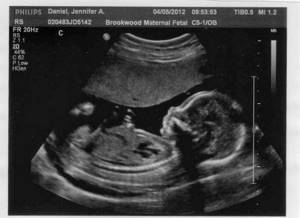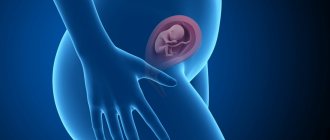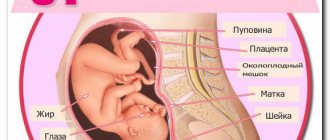Interesting Facts
| Options | Indications |
| Time from conception | 36 weeks |
| Period by month | 38 weeks |
| What month | 9 |
| Dimensions and weight of the fetus | 500 mm, 3000 g |
| Uterus dimensions | VDM - 34-37 cm |
| Pregnant weight | Gain from the beginning of pregnancy is 10-15 kg; over the last week 200-300 g |
Your baby is the size of
Leek
500mm Size
3000 g Weight
Most babies are born between 38 and 40 weeks. So the birth is already near. You're probably tired, and the best thing you can do for yourself is to get regular sleep. Don't sacrifice your sleep for other things, go to bed on time. After all, a child can decide to be born at any time. And it is important for you to be fully armed, full of strength and positive energy. Our calendar will tell you what you need to be prepared for in the thirty-eighth week of pregnancy.
Decoding the results
The research data is transferred to a form that the woman will provide to her gynecologist. It notes the expected height and weight of the fetus, its gender, condition and amount of amniotic fluid.
The location of the placenta and its degree of maturity are also indicated. The doctor will examine the placenta; its structure is important to determine the degree of functionality. At 38 weeks, the placenta ages, providing the fetus with less nutrients and oxygen. The degree of her maturity is now mainly second or third, and her weight ranges from 450 to 600 g. If the baby’s place does not perform its functions well, measures will be taken for urgent delivery.
What to pay attention to
Since the baby is already quite large, the doctor examines body parts and organs separately from different angles, making all the necessary measurements and calculations. Pay attention to the fetal heart rate, the degree of its activity, and its size in accordance with the norm for fetometry.
What does a child look like?
The baby's facial features are already formed, plump cheeks appear due to the increase in subcutaneous fat. The child's ears become harder and sharper nails grow. The fetus descends lower into the pelvis, in most cases - head down, taking the correct presentation. If the baby is sitting “on his butt,” this may be an indication for a cesarean section, since natural childbirth will be very difficult.
Child behavior
If you perform a 3D ultrasound, you can see the face of your unborn child. He winces, grimaces, sucks his thumb like a newborn baby, and even plays with the umbilical cord.
At this stage, there is little space in the uterus, the fetus moves less often and no longer tumbles as before, taking the head-down position before birth. The head is lowered into the mother's pelvis. He has already formed periods of sleep and wakefulness, so the mother may feel that the child is sleeping longer than usual, or is not as active, and become worried.
Fetometry fetal size at 38 weeks
Indicators of normal development in this gestational age (child size on ultrasound at 38 weeks) are as follows:
- height from head to feet – 45-52 cm, weight – about 3000 g;
- BPR is 850-100 mm;
- fronto-occipital size – from 108 to 128 mm;
- OG (fetal head circumference) is 309-360 mm;
- Coolant (abdominal circumference) is 304-368 mm.
Normal sizes of long bones
The sonologist must also determine the length of the bones of the limbs, which at this intrauterine age are:
- femoral - from 6.8 to 7.8 cm;
- shins - from 6.6 to 6.8 cm;
- shoulder – from 6 to 7 cm;
- forearm – from 5.2 to 6 cm.

Special situations if ultrasound results do not correspond to the gestational age
In some cases, there is a discrepancy between the sizes that should be when the pregnancy is 38 weeks old according to ultrasound. For example, bone length, height and weight of the fetus lag behind normal values. If it is developed proportionally, then, most likely, hereditary factors influenced it, and the child will be small.
If a disproportion in size is established, for example, long bones correspond to fetometric standards, but height and weight lag behind, then we can talk about IUGR - intrauterine growth retardation.
Perhaps, based on additional examinations (Doppler, CTG) and tests, the doctor will decide to induce labor. At this stage, the baby is considered mature and its viability is not a concern. In the womb, if hypoxia, pathology of blood flow or failure of the postoperative scar is confirmed, his health will be at risk, therefore, further tactics for managing pregnancy and delivery should be developed by a gynecologist.
How does a woman feel?
At 38 weeks of pregnancy, every expectant mother carefully listens to her feelings and waits for the onset of labor. Are there signs that indicate their approach? Such symptoms are called precursors of labor. They are common to both primiparous and multiparous women, but in the latter they may appear 1-2 weeks earlier:
- Training contractions - you can feel how the lower abdomen pulls from time to time, but the pain does not increase.
- The discharge of the mucus plug is a thick mass, similar in consistency to jelly, sometimes with brown streaks, coming out of the cervical canal under the influence of estrogens.
- Abdominal prolapse occurs when the baby presses its head against the entrance to the pelvis and takes the most comfortable position for birth. And your shortness of breath and heaviness in your stomach will disappear, because the uterus no longer puts so much pressure on the diaphragm area.
- Weight loss of 1.5 kg is due to the removal of excess fluid. You may notice that swelling has decreased, you feel like you need to go to the toilet more often, and the consistency of your stool changes, even to the point of diarrhea.
It is not necessary that you will find all the warning signs. And even if you have all the signs, not a single specialist can tell you with 100% accuracy when labor will begin. There is only an approximate date. But, of course, it’s worth packing your bag for the maternity hospital.
Recommendations
There is very little time left before giving birth, so when leaving home at 38 weeks of pregnancy, always take an exchange card with you. Be sure to check whether it reflects information about the results of previously performed tests, especially for staphylococcus, HIV and syphilis, and whether there is a note about fluorography.
The 38th week of pregnancy is a good time to complete various things. See what else is missing and go shopping or make a detailed list for your husband.
A few weeks before giving birth, you need to make changes to your diet. It is recommended to exclude hard-to-digest foods, legumes, red meat, mushrooms, pearl barley porridge, and brown rice. This will prepare the digestive system and cleanse the intestines. But at the same time, the food must be sufficiently high in calories. In the 37th - 38th week of pregnancy, increase the amount of protein you consume through dairy products, fish and eggs. In addition, milk, kefir and cottage cheese contain a lot of calcium and potassium, which your baby needs at this stage.
To reduce swelling, monitor the amount of fluid you drink and excrete, limit your intake of salt and sugar, and completely avoid smoked, pickled and spicy foods. Fasting days will help regulate weight gain.
Sex between 37 and 38 weeks of pregnancy can trigger labor. Follow the instructions of your gynecologist, and if the doctor has prohibited sexual intercourse, do not ignore it.
What happens to the fetus at 38 weeks
The baby's size is increasing day by day. Now he is about 3 kg and on average 50 cm. He is completely ready for life outside his mother’s belly, but when he decides to be born is a mystery. Only about 30% of babies are born according to gynecologist calculations.
Despite the fact that the entire skeletal system of the fetus is formed, the bones of its skull remain soft and flexible. This is necessary for successful passage through the birth canal. During the first months of life, the skull will take on its usual shape, the bones will grow together and harden.
Tests and ultrasound
In the last trimester of pregnancy, the gynecologist will ask you to come in for an appointment every week. In addition to the usual measurements of weight, pressure, abdominal circumference, fundal height of the uterus, he will be interested in your general health and the results of a urine test. For example, protein in the urine, weakness and nausea may indicate the development of gestosis in pregnant women, which requires emergency delivery.
Another mandatory study is cardiotocography. It will help diagnose the tone of the uterus, assess the baby’s heart rate, and the degree of maturity of the placenta. Based on these data, the specialist will be able to understand whether everything is okay with the fetus, whether there is hypoxia, and whether enough nutrients are supplied to it through the placenta.
Advantages of fetometry at the Doctor Nearby clinic

In the clinics of the Doctor Nearby network, all conditions have been created to ensure that pregnant patients feel safe and are confident that the diagnosis will be carried out in accordance with international medical standards. By contacting us, future parents can count on attentive attention and accurate results.
We do not have queues, since appointments are by appointment only. It can be held at any time convenient for you. Call: +7 (495) 153-01-33!
What to discuss with your doctor
- If it seems to you that the child is moving a lot or, conversely, you hardly feel him during the day, be sure to seek medical help. Fetal motor activity and 10 movements in 12 hours are the norms that indicate the absence or presence of hypoxia.
- Get advice on how to properly prepare your vagina for childbirth at 38 weeks of pregnancy. If previously your smears were clean, but you have a tendency to dysbiosis, now your doctor may recommend vaginal suppositories with lactobacilli, for example, Acylact, to prevent inflammatory processes. If you suddenly have yellow or curdled discharge, be sure to consult about the possibilities of treating thrush at your time.
Ultrasound fetometry of the fetus
Ultrasound fetometry is a safe, absolutely painless, but at the same time highly informative method.
During the process, the ultrasound specialist compares the data obtained with the average norms, which allows one to draw conclusions about the quality of the gestation process and about existing deviations. The procedure is widely used to determine the exact timing of conception. Thanks to it, it is possible to determine the gestational age of the fetus with an accuracy of up to 96 hours. The normal indicators, which are used by diagnosticians all over the world, are brought to general standards and determined by the corresponding tables.
Possible complications
There are conditions and changes in the feelings of the expectant mother on the eve of childbirth, in which you should immediately seek medical help in a hospital:
- Scarlet, bright red discharge, even small in volume. Blood at 38 weeks of pregnancy is always an alarming sign.
- Severe and sharp abdominal pain, unbearable headache and visual disturbances.
- Suspicion of leakage of amniotic fluid. You may suddenly notice that the laundry becomes wet, the discharge is completely transparent, colorless and odorless.
- Increased blood pressure and temperature, tachycardia and a sharp increase in swelling are possible signs of gestosis.
- Nausea, vomiting, dizziness and dry skin - this is how oligohydramnios can manifest itself at 38 weeks of pregnancy.
How is ultrasound performed?
scanning usually takes 20 to 30 minutes. The inspection does not require special preparation. Before the first ultrasound at 10-14 weeks, it is recommended to drink 1-1.5 liters of water an hour before the procedure. This will improve the visibility of the fetus.
The expectant mother needs to lie down on the couch, raise her outerwear to her chest and lower her skirt or pants to her upper thighs to expose her stomach. A transparent gel is applied to the skin, which ensures good contact between the skin and the device, and also promotes better transmission of sound waves.
The technician runs an ultrasound machine over the abdomen. The device emits high-frequency sound waves, and a computer measures how they bounce off cells and tissues and converts the signal into a black-and-white image that is displayed on a screen.
An ultrasound is painless, but the doctor may have to press quite hard on your abdomen from time to time to see deeper structures. This may cause minor discomfort to the expectant mother.
Sometimes ultrasound is performed through the vagina (transvaginal ultrasound). This method is used in the early stages of pregnancy, when the uterus and ovaries are better visible from this angle.
Lifestyle
The most important thing in the last weeks of pregnancy is to worry and worry less. Go for a walk, meet with friends, don’t forget about your favorite activities, books and films. After giving birth, all your attention will be focused on your newborn, so now dedicate this time to yourself.
Is intimate life possible?
If the pregnancy proceeds calmly and without complications, most experts do not prohibit physical intimacy in the last weeks. And in some cases, sex is even recommended as a method of stimulating labor. Indeed, seminal fluid contains substances that promote rapid dilatation of the cervix. However, we recommend that you listen carefully to your feelings, choose positions that are safe for your stomach, and do not rush things. The baby will be born at the allotted time. Meanwhile, the vaginal microflora is now especially sensitive to any changes.
Table of sizes, weight and other indicators of the fetus
We invite you to familiarize yourself with the averaged data on various indicators of fetal development by week. They are presented in our table below.
| Week of pregnancy | Height | Weight | DB | BPR | OG |
| 11 | 6.8 cm | 11 g | 7 mm | 18 mm | 20 mm |
| 12 | 8.2 cm | 19 g | 9 mm | 21 mm | 24 mm |
| 13 | 10.0 cm | 31 g | 12 mm | 24 mm | 24 mm |
| 14 | 12.3 cm | 52 g | 16 mm | 28 mm | 26 mm |
| 15 | 14.2 cm | 77 g | 19 mm | 32 mm | 28 mm |
| 16 | 16.4 cm | 118 g | 22 mm | 35 mm | 34 mm |
| 17 | 18.0 cm | 160 g | 24 mm | 39 mm | 38 mm |
| 18 | 20.3 cm | 217 g | 28 mm | 42 mm | 41 mm |
| 19 | 22.1 cm | 270 g | 31 mm | 44 mm | 44 mm |
| 20 | 24.1 cm | 345 g | 34 mm | 47 mm | 48 mm |
| 21 | 25.9 cm | 416 g | 37 mm | 50 mm | 50 mm |
| 22 | 27.8 cm | 506 g | 40 mm | 53 mm | 53 mm |
| 23 | 29.7 cm | 607 g | 43 mm | 56 mm | 56 mm |
| 24 | 31.2 cm | 733 g | 46 mm | 60 mm | 59 mm |
| 25 | 32.4 cm | 844 g | 48 mm | 63 mm | 62 mm |
| 26 | 33.9 cm | 969 g | 51 mm | 66 mm | 64 mm |
| 27 | 35.5 cm | 1135 | 53 mm | 69 mm | 69 mm |
| 28 | 37.2 cm | 1319 | 55 mm | 73 mm | 73 mm |
| 29 | 38.6 cm | 1482 | 57 mm | 76 mm | 76 mm |
| 30 | 39.9 cm | 1636 | 59 mm | 78 mm | 79 mm |
| 31 | 41.1 cm | 1779 | 61 mm | 80 mm | 81 mm |
| 32 | 42.3 cm | 1930 | 63 mm | 82 mm | 83 mm |
| 33 | 43.6 cm | 2088 | 65 mm | 84 mm | 85 mm |
| 34 | 44.5 cm | 2248 | 66 mm | 86 mm | 88 mm |
| 35 | 45.4 cm | 2414 | 67 mm | 88 mm | 91 mm |
| 36 | 46.6 cm | 2612 | 69 mm | 89.5 mm | 94 mm |
| 37 | 47.9 cm | 2820 | 71 mm | 91 mm | 97 mm |
| 38 | 49.0 cm | 2992 | 73 mm | 92 mm | 99 mm |
| 39 | 50.2 cm | 3170 g | 75 mm | 93 mm | 101 mm |
| 40 | 51.3 cm | 3373 g | 77 mm | 94.5 mm | 103 mm |
Checklist for 38 weeks of pregnancy
- Don't miss visits to the gynecologist! In the third trimester, it is important to notice the first signs of complications in time and provide medical assistance.
- Decide how you will get to the maternity hospital: by ambulance or by your spouse or other relative. It is worth driving the route to the maternity hospital in advance so that in case of a stressful situation you will not be distracted by finding the way.
- Don't forget about breathing exercises and Kegel exercises. This will be very useful to you during the birth process.
You can learn more about preparing for childbirth, breastfeeding and caring for a newborn at courses for expectant mothers at the Women's Medical Center. Additional knowledge and communication with like-minded people is another good way to cope with the anxiety inherent in expectant mothers in the 3rd trimester of pregnancy.
Good to know
A treacherous loop. Umbilical cord entanglement
Childbirth: when to go to the maternity hospital and how will I give birth? Contraction Guide
When to go to the maternity hospital? In an ambulance or on your own?
Secret language. What do doctors talk about during childbirth?
How can you tell when labor is starting?
How do you know when you're about to give birth? Harbingers: 9 signs of impending birth
All texts for pages about mother and baby were kindly provided by RAMA Publishing - these are chapters from the book by Svetlana Klaas “Your Favorite Little Man from Conception to Birth”, reviewer Irina Nikolaevna Kononova, Candidate of Medical Sciences, Associate Professor of the Department of Obstetrics and Gynecology of the Ural State Medical Academy (Ekaterinburg).









